SIA Blog 6
This week we began storyboarding our idea with the aid of Erkki Hedenborg, our academic mentor. We discussed many alternative options and finally honed our digital idea into a designed interactive game for social cohesion and community exploration.
During the beginning of the session we began drafting potential ideas for a digital solution, initial ideas started as digital interventions placed around Wingrove in specific points that would advertise activities and allow users to interact with it, by sound or movement for instance. We then moved on to discuss this interaction in a more physical manner by creating an interactive game. With this, users would gain insight into the Wingrove area, meet other locals, and gaining knowledge of potential activities happening. This is important as those we questioned in our door-to-door survey did note that they did not know of many activities taking place within the area.
The idea stems from the concept of location based GPS games such as Pokemon Go, Geocaching, and ActionBound, in which users have to explore an area to earn rewards or learn things about the specific area chosen. We wanted to replicate this idea by giving young adults/teenagers/kids the option to discover Wingrove and connect with other users to enhance their social connections within the area.
Potential ideas for prototyping this concept could initially be a piece of paper with set questions or facts on it and use of google maps to navigate the treasure hunt. Those using the game would have a set route to follow and have to pick up points along the way that would collate into a final league board, with those with the most points earning prizes or gift vouchers (potentially). Some reservations are held by having incentives to play the game, however we did then lead onto looking at having proactive rewards such as a free one hour music session, or one free activity session at the Nuns Moor centre. In doing this, this improves the users awareness of activities within the area, therefore subverting their attention indirectly to other recreational activities for the youth to engage with within Wingrove.
Below are some initial mind-mapping/sketching that led us to the interactive game idea.
.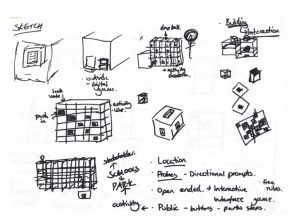
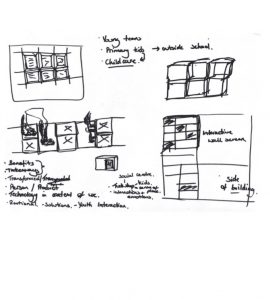
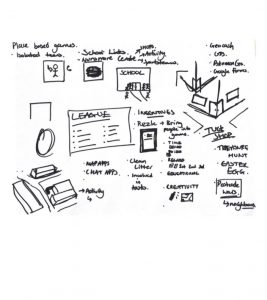
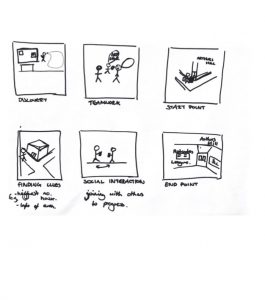
User Research
From this we took insight from our user research, as many of the people we interviewed discussed the need for more youth programmes and activities, by using the game idea it gives teenagers and kids the opportunity to play outside and embrace their area rather than having nothing to do. In addition, the use of the Arthurs Hill building as a central addition to the game to engage the youth of the area with the activities going on there, thus indirectly creating a youth centre/central point by having them physically visit the building. Katrina and David Webb both spoke about the need for youth engagement within the area, we feel targeting this group will then set the path for future generations to converse with one another and begin a narrative with them in Arthurs Hill and community engagement.
After including our user research we developed a final storyboard proposal which depicts the narrative of downloading the game to the end point of the game.
Storyboard
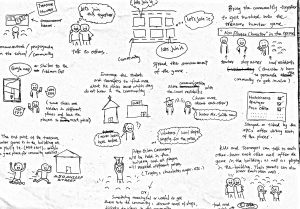
Next Steps
Our next steps include refining the game idea, deciding where the set routes would be, as well as potentially including different interfaces for alternative uses. The game idea does hold some reservations as we do need to define what exactly the user is putting in and getting out of the game, what sets this idea apart that would make users want to actively engage with it and also, perhaps developing what else the interface can offer, so that we define exactly how it meets our project aims.
Hello, this post demonstrates clear development of your thinking in relation to that on sketching. With the storyboard, a clearer narrative emerges. You are also starting to embed and relate your ideas to the local context and people (e.g. thinking about incentives — ” free one-hour music session, or one free activity session at the Nuns Moor centre”). That’s really strong. Please continue to explore the nuances of the interactions users will be able to do and how this relates to the local area and the needs of the people there. At some point, you will have a version 2 / final story board. Onwards.
Hi team, well done on the detailed post here. Building on Sebastian’s comments, I like how you are building up from the knowledge you have obtained from community partners. This ensures that your project is well grounded and has a better chance of representing a sustainable proposition. I like how you are also subverting the idea of Pokemon Go (where everyone complained it glued children to their phones) by incentivising participation in the community offline. The games then become a gateway to participation in civic activities. If you hadn’t made this connection yet, explore it further because it’s really good. Just note that other scholars have tried to do similar things before but it’s not always been clear how successful it has been at connecting young people to their community, so make sure you have this in mind.